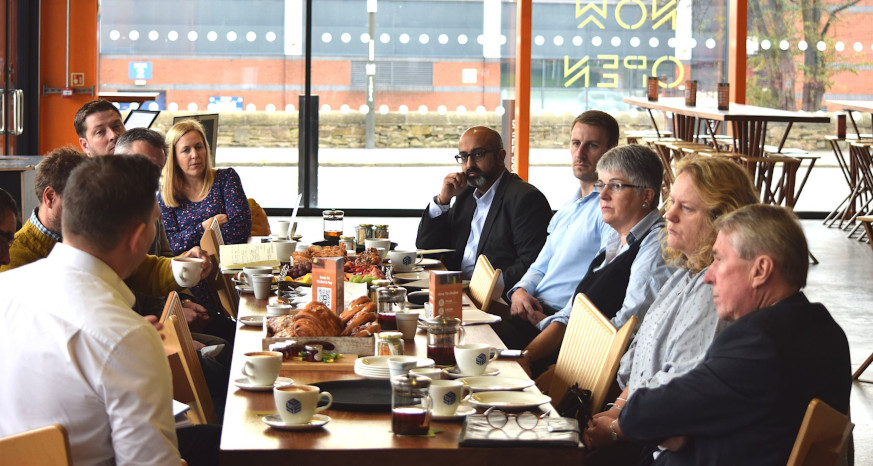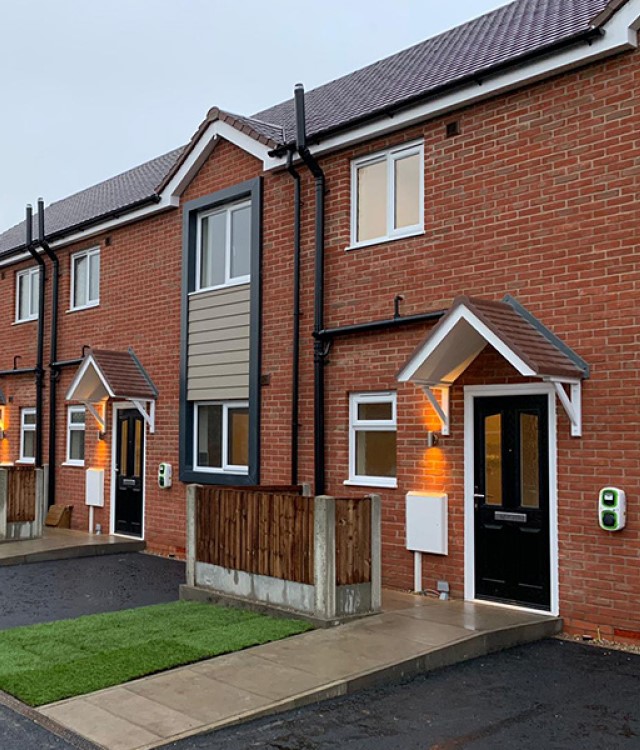How Chesterfield can be a leader in sustainable housing
How can Chesterfield become a national leader in sustainable housing development for the future? That was the question posed to construction leaders in Chesterfield recently.
The town’s Property and Construction Group gathered to discuss the importance of green development across the town.
Chesterfield Borough Council has set a target of ensuring Chesterfield is a ‘net-zero’ borough by 2050. The organisation is working closely with the sector to find solutions across a range of developments. That includes in both housing and commercial property builds.
Using technology to support sustainable housing
The group first discussed how technological advancements are playing a role in bringing emissions down. Liam Rodda, Business Development Manager at Samsung spoke of the increase in the use of heat pumps in new houses. It is hoped the technology will become just as cost-effective as gas boilers in the coming years.
Liam said: “If you’re putting a heat pump into a new build, there’s not actually a great deal of cost difference compared to a boiler.
“The reality is that heat pumps are easier to fit than most gas boilers. Most competent engineers will be able to upskill in order to fit them pretty quickly. I’m hoping we will see prices come down as we get more labour into it.”
Chesterfield is set to lead the way when it comes to training more heat pump installers. This is thanks to the opening of a newly refurbished training centre by NIBE. Read more about the development, which opened in late 2022 here.
Improving green skills in Chesterfield to power our future
Sustainable skills will also be at the forefront of the new Construction Skills Hub, which is set to be developed in Mastin Moor.
Lynda Sharp, Economic Development Manager at Chesterfield Borough Council spoke about the benefits of the new facility.
Lynda said: “The hub will be an on-site facility linked to a housing scheme at Mastin Moor. That is a fantastic opportunity for young people to gain experience of a live construction site, which will make a big difference locally.”
Another issue raised during the discussion was the viability of retrofitting and insulating existing housing stock, to increase the amount of sustainable housing in Chesterfield.
Jillian Mitchell, of Lomas & Mitchell Architects and Vice-Chair of the Chesterfield Property and Construction Group said: “The big challenge to me in retrofit is how you insulate an existing property without creating more risk of condensation and mould growth.
“The market is so familiar with talking about insulation, and they haven’t really talked about ventilation. Derbyshire is a county where there is a lot of brick and stone, so insulating existing properties is a challenge.”
Cost and viability
Concerns around the cost of sustainable housing was one of the concerns which the forum felt needed to be addressed.
Jillian added: “A lot of what has been done in this country has been incentivised financially. But this has not encouraged people to change their behaviour. A lot of that financial reward seems to be how our industry is driven.
“In Cyprus, they have a scheme where people are able to install a limited amount of PV (solar panels). They are only rewarded if they change their behaviour and reduce the amount of electricity they use. I think that’s what we should be thinking about doing.”
Jim Lomas, Director at DLP Planning Ltd. believes recent climate events have made the sector more focused on cutting emissions, and increasing the number of sustainable housing in Chesterfield: “I certainly think the previous summer has started to focus people’s attention. People have seen some tangible changes in the environment, and it is bringing the issues we face to people’s attention.
“From a construction perspective, we are all probably very informed and alert to it. But the wider public are probably not, and now the penny is beginning to drop. There has to be a cultural change.”
Samsung’s Liam Rodda does believe that new builds are starting to improve from a sustainability point of view: “Terraced houses were built to house a lot of people, very quickly. New builds today are going in the right direction. We’re ticking those boxes more often where the homes are generating their own electricity as much as possible.”
John Short, of JAB Short Ltd. was in agreement, but felt that more focus should be placed on existing buildings in order to make significant change: “It is the existing housing stock that we need to be concentrating on, because that is what will make the huge steps required.”
Working collaboratively to drive change
Jim Lomas stressed the importance of ensuring the younger generation have their say in future developments: “We have got to look at the future generations. Young people will be wanting something more sustainable and will be demanding energy efficient buildings from businesses. We need to give younger people more of a voice and direction in developments because it is their future. However, the viability of schemes is pivotal.”
The session was further evidence of the strong partnership between the private and public sectors in Chesterfield continuing to have an impact.
Lynda Sharp added: “From my point of view, the level of detail and quality of the conversation today shows that we are gaining a greater collective understanding and getting deeper into the issues at hand. From a commercial property perspective, the recently-developed Northern Gateway Enterprise Centre and One Waterside place offices are really good examples of where we should be going.”
Chesterfield’s Property and Construction Group brings together business leaders of the region’s property sector and Chesterfield Borough Council to shape and drive forward collaboration, investment, sustainability and skills within Chesterfield.
Regular forums and networking events are held by the group throughout the year.
If you would like to get involved, find out more about the group at: https://www.chesterfield.co.uk/propertygroup/ or find out more on Linkedin.




